Статьи журнала - International Journal of Computer Network and Information Security
Все статьи: 1066
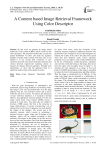
A Content based Image Retrieval Framework Using Color Descriptor
Статья научная
In this work, we propose an image search method by visual content (CBIR), which is based on the color descriptor. The proposed method take account the spatial distribution of colors and make the signature partially invariant under rotation. The basic idea of our method is to use circular shift (clockwise or anti-clockwise direction) and mirror (horizontal direction and vertical direction respectively) matching scheme to measure the distance between signatures. Through some experiments, we show that this approach leads to a significant improvement in the quality of results.
Бесплатно
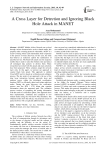
A Cross Layer for Detection and Ignoring Black Hole Attack in MANET
Статья научная
MANET Mobile Ad hoc Network are evolved through various characteristics such as shared media, this property make a routing protocols vulnerable. AODV is a reactive routing where each intermediate node cooperates in the process of route discovery. In this case, the node that behaves as malicious exploit the malfunction of specified service. The black hole attack uses the sequence number that is used to select the freshest route and attract all exchanged data packets to destroy them. Many researchers have dealt with this attack and many solutions have been proposed. These solutions target the network layer only. In this paper, we present our approach to counter black hole attack. This approach is entitled CrossAODV and it is based on verification and validation process. The key point of our approach is the use of the inter layer interaction between networks layer and medium access within the distributed coordination function (DCF) to efficiently detect and isolate malicious nodes. During the route discovery, the verification process uses the RTS / CTS frame that contains information about the requested path. The validation process consists of comparing the routing information with the result of verification phase. Our Approach have been implemented, simulated and compared to two related studies using the well know NS2 Simulator. The obtained results show the efficacy our proposal in term of packet delivery with a neglected additional delay.
Бесплатно

A Cross-Layer Design and Fuzzy Logic based Stability Oriented Routing Protocol
Статья научная
Ad-hoc networks in which nodes are mobile as well as communicate via wireless links fall under the category of mobile ad-hoc networks (MANETs). Evasive mobility and the limited battery life of MANET nodes make routing a difficult problem. Most of the conventional routing protocols recommend the shortest path without considering route stability into account. A Cross-Layer Design and Fuzzy Logic based Stability Oriented (CLDFL-SO) routing protocol is proposed in this research, which offers a solution for stable route formation by eliminating unstable links and low-quality nodes. Cross-layer interaction parameter based link residual lifetime calculation is used to assess the link's stability. The fuzzy logic is being used to evaluate the node quality by providing node metrics like node speed, residual energy and node degree. The simulations illustrate the efficacy of the suggested protocol in comparison to the popular Ad-hoc On-Demand Distance Vector (AODV) protocol.
Бесплатно
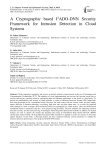
A Cryptographic based I2ADO-DNN Security Framework for Intrusion Detection in Cloud Systems
Статья научная
Cloud computing's popularity and success are directly related to improvements in the use of Information and Communication Technologies (ICT). The adoption of cloud implementation and services has become crucial due to security and privacy concerns raised by outsourcing data and business applications to the cloud or a third party. To protect the confidentiality and security of cloud networks, a variety of Intrusion Detection System (IDS) frameworks have been developed in the conventional works. However, the main issues with the current works are their lengthy nature, difficulty in intrusion detection, over-fitting, high error rate, and false alarm rates. As a result, the proposed study attempts to create a compact IDS architecture based on cryptography for cloud security. Here, the balanced and normalized dataset is produced using the z-score preprocessing procedure. The best attributes for enhancing intrusion detection accuracy are then selected using an Intelligent Adorn Dragonfly Optimization (IADO). In addition, the trained features are used to classify the normal and attacking data using an Intermittent Deep Neural Network (IDNN) classification model. Finally, the Searchable Encryption (SE) mechanism is applied to ensure the security of cloud data against intruders. In this study, a thorough analysis has been conducted utilizing various parameters to validate the intrusion detection performance of the proposed I2ADO-DNN model.
Бесплатно
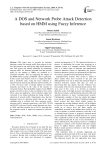
A DOS and network probe attack detection based on HMM using fuzzy inference
Статья научная
This paper aims to provide an intrusion detection system for network traffic that achieves to the low false positive rate with having high attack detection rate. This system will identify anomalies by monitoring network traffic. So, Features extracted from the network traffic by the number of HMM, are modeled as a Classifier ensemble. Then by integrating the outputs of the HMM within a group, probability value is generated. In this system each feature receives a weight and rather than a threshold value, using the fuzzy inference to decide between normal and abnormal network traffic. So at first, the fuzzy rules of decide module are formed manually and based on the value of the security of extraction feature. Then probability output of each HMM groups converted to fuzzy values according to fuzzy rules. These values are applied by a fuzzy inference engine and converted to an output indicating the being normal or abnormal of network traffic. Experiments show that the proposed system in detecting attacks that are the main candidate error is working well. Also, measures recall, precision and F1-measure respectively with 100%, 99.38% and 99.69% will pass. Finally, attack detection rate close to 100% and false positive rate of 0.62%, showing that the proposed system is improved compared to previous systems.
Бесплатно

A Detailed Analysis of Grain family of Stream Ciphers
Статья научная
Hardware based ciphers are most suitable for resource constrained environments to provide information security and confidentiality. Grain is one such hardware based synchronous stream cipher. The motive of this study is to present a comprehensive survey and review of Grain family of stream ciphers that is one of the portfolio candidates in the hardware based category of eSTREAM. Security features and different attacks on these ciphers have been studied in this paper to analyze the strengths and weaknesses of these designs.
Бесплатно
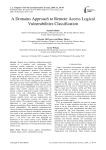
A Domains Approach to Remote Access Logical Vulnerabilities Classification
Статья научная
Remote access facilitates collaboration and the creation of a seamless work environment. This technology enables employees to access the latest versions of data and resources from different locations other than the organization’s premises. These additional locations include home or untrusted networks not governed by the organization's security policy and baseline. Balancing between security and accessibility is a significant challenge. Remote access can be a high-security risk if not correctly safeguarded and monitored. This paper presents some technologies and methods for remote access. It then highlights security concerns, attack vectors, and logical vulnerabilities in remote access. To address these security concerns and weaknesses, we present a domains approach to logical vulnerabilities in remote access and vulnerability scoring using the Common Vulnerability Scoring System (CVSS). Domains simplify device and user authentication and separate the organization network into logical and discrete entities. The separation enables a unique security application to each domain. Vulnerability scoring enhances remediation efforts through prioritization of the logical vulnerabilities. The approach comprehensively covers all points of compromise during remote access and contributes to effective logical vulnerability management. The results of the experiments provide evidence that all remote access domains have a high severity rating of at least a 7.28 CVSS score. Our study highlights the drawbacks of the current remote access methods and technologies such as the Virtual Private Network (VPN) and shows the importance of securing all domains during remote access.
Бесплатно
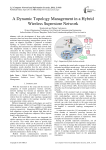
A Dynamic Topology Management in a Hybrid Wireless Superstore Network
Статья научная
With the development of large scale wireless networks, there has been short comings and limitations in traditional network topology management systems. In this paper, an adaptive algorithm is proposed to maintain topology of hybrid wireless superstore network by considering the transactions and individual network load. The adaptations include to choose the best network connection for the response, and to perform network Connection switching when network situation changes. At the same time, in terms of the design for topology management systems, aiming at intelligence, real-time, the study makes a step-by-step argument and research on the overall topology management scheme. Architecture for the adaptive topology management of hybrid wireless networking resources is available to user’s mobile device. Simulation results describes that the new scheme has outperformed the original topology management and it is simpler than the original rate borrowing scheme.
Бесплатно
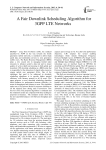
A Fair Downlink Scheduling Algorithm for 3GPP LTE Networks
Статья научная
Long Term Evolution (LTE), the standard specified by 3GPP on the way towards the fourth generation mobile networks, is intended to deliver high speed data and multimedia services to next generation mobile users. The Radio Resource Management (RRM) plays a very crucial role in managing limited radio resources to enhance system's data rate and to ensure quality of service (QoS) provisioning in both uplink and downlink. LTE downlink scheduling is a RRM entity that is responsible for the allocation of shared radio resources among mobile user equipment (UEs). One of the challenges that need to be addressed in downlink scheduling algorithms is to provide higher spectral efficiency with fairness ensured to all its users. This paper proposes a novel downlink scheduling algorithm which balances its performance between efficiency (in terms of throughput) and fairness to users. The algorithm makes use of Assignment Model for resource allocation to all the selected users during each Transmission Time Interval (TTI). The proposed algorithm is simulated and the simulation results are compared with three techniques proposed in literature. The simulator results show that the new algorithm balances well between throughput and fairness.
Бесплатно
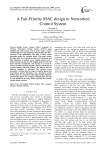
A Fair-Priority MAC design in Networked Control System
Статья научная
Media Access Control (MAC) protocols in Wireless Networked Control System (WNCS) must minimize the radio energy costs in sensor nodes. Latency and throughput are also important design features for MAC protocols in the applications. But most of them cannot guarantee quality for real-time traffic. This paper studies the state of the art of current real-time MAC protocols, and then introduces a medium access control protocol and a improved protocol that provide multiple priority levels and hard real-time transmission. The channel is accessed by sensors according to their priorities. Sensors send frames in a round manner with same priority. The fairness between different priorities is provided. The channel access procedure is divided into two stages: broadcast period and transmission period. Simulation and experiment results indicate that our protocol provides high channel utilization and bounded delays for real-time communication and can be well applied in the many fields especially the dynamic wireless sensor networks.
Бесплатно
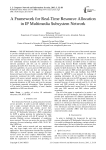
A Framework for Real-Time Resource Allocation in IP Multimedia Subsystem Network
Статья научная
IMS (IP Multimedia Subsystem) is designed to provide multiple-services and can be accessed from any access network. With the advent of new multimedia services; user requirement also changed and required delay tolerant services from the service providers. The new multimedia services demands the restrictions on network parameters and this can be achieved by analyzing the traffic flow from the core as well as access network capabilities. As access and core IMS network are independent of each other and does not exchange user SLA with each other. In this paper we proposed framework based on Session border controller (SBC) that proactively monitored the traffic statistics as well as interact with access network operator for getting user's SLA and reserve resources accordingly. We are also proposing alterations in SIP invite and re-invite message to incorporate requested information. These alterations will be useful in ensuring availability of user's handset capabilities to IMS core network.
Бесплатно
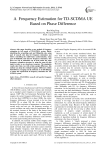
A Frequency Estimation for TD-SCDMA UE Based on Phase Difference
Статья научная
This paper describes a new method of frequency estimation in cell search of TD-SCDMA system. Before identifying the scrambling code and Midamble code, using part of sync-dl code data for frequency estimation; and before controlling the multi-frame synchronization, using part of Midamble code data for frequency estimation. Also these two sets of estimation can be done under the same frequency estimation structure by using the same 64 chip input in order to save hardware resources. The simulation results show that even with certain sample differences, this method can keep the residual frequency differences within 0.05 PPM by averaging out the subframe or by IIR filtering to satisfy the requirement of frequency estimation for TDSCDMA system.
Бесплатно
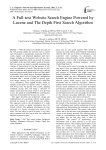
A Full-text Website Search Engine Powered by Lucene and The Depth First Search Algorithm
Статья научная
With the amount of available text data on the web growing rapidly, the need for users to search such information is dramatically increasing. Full text search engines and relational databases each have unique strengths as development tools but also have overlapping capabilities. Both can provide for storage and update of data and both support search of the data. Full text systems are better for quickly searching high volumes of unstructured text for the presence of any word or combination of words. They provide rich text search capabilities and sophisticated relevancy ranking tools for ordering results based on how well they match a potentially fuzzy search request. Relational databases, on the other hand, excel at storing and manipulating structured data -- records of fields of specific types (text, integer, currency, etc.). They can do so with little or no redundancy. They support flexible search of multiple record types for specific values of fields, as well strong tools for quickly and securely updating individual records. The web being a collection of largely unstructured document which is ever growing in size, the appeal of using RDBMS for searching this collection of documents has become very costly. This paper describes the architecture, design and implementation of a prototype website search engine powered by Lucene to search through any website. This approach involves the development of a small scale web crawler to gather information from the desired website. The gathered information are then converted to a Lucene document and stored in the index. The time taken to search the index is very short when compared with how long it takes for a relational database to process a query.
Бесплатно

A Generic Middleware Model for Smart Home
Статья научная
A Smart Home is an emerging technology, where the electronic devices are controlled automatically based on the occupants activities. The pervasive computing plays a vital role in the smart home environment, which provides the computer-based service to human beings anywhere and anytime. However, when discussing smart home of the future, related studies have focused on providing middleware. The middleware acts as a interface between human beings and the smart devices. In this paper, we have proposed a generic middleware model for smart home that enables interaction between human being and devices and also between various devices based on the context identified in the environment.
Бесплатно
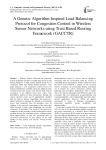
Статья научная
Wireless Sensors Networks are extremely densely populated and have to handle large bursts of data during emergency or high activity periods giving rise to congestion which may disrupt normal operation. Our paper proposes a new congestion control protocol for balanced distribution of traffic among the different paths existing between the Source node and the Sink node in accordance to the different route trust values. This probabilistic method of data transmission through the various alternate routes can be appropriately modeled with the help of Genetic Algorithms. Our protocol is mainly targeted in selecting the reliable or trustworthy routes more frequently than the unreliable ones. In addition, it also prevents concentration of the entire data traffic through a single route eliminating any possible occurrence of bottleneck. The merits of our protocol in comparison to the presently existing routing protocols are justified through the simulation results obtained which show improvements in both the percentage ratio of successful transmission of data packets to the total number of data packets sent and the overall network lifetime.
Бесплатно
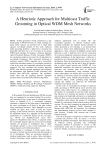
A Heuristic Approach for Multicast Traffic Grooming in Optical WDM Mesh Networks
Статья научная
Traffic grooming is being considered as a key functionality of WDM networks, in which, multiple low speed traffic requests are groomed into a single high capacity wavelength channel. In this work, multicast traffic grooming problem is addressed to maximize the bandwidth utilization for a set of sessions in an optical WDM mesh topology. We propose a heuristic approach called Prioritized Multicast Traffic Grooming (PMTG) for constructing multicast tree and a first fit algorithm for wavelength assignment. After successful grooming of multicast requests, PMTG algorithm have successfully reduced the maximum number of wavelengths required in a link at the same time bandwidth utilization has greatly improved. We have simulated the heuristic approach PMTG with different network topologies and compared the performance with Multicast Traffic Grooming with Shortest Path (MTG-SP) algorithm. The simulation results show that the proposed heuristic algorithm produces better result than MTG-SP based algorithm.
Бесплатно
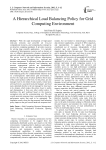
A Hierarchical Load Balancing Policy for Grid Computing Environment
Статья научная
With the rapid development of high-speed wide-area networks and powerful yet low-cost computational resources, grid computing has emerged as an attractive computing paradigm. It provides resources for solving large scientific applications. It is typically composed of heterogeneous resources such as clusters or sites at different administrative domains connected by networks with widely varying performance characteristics. The service level of the grid software infrastructure provides two essential functions for workload and resource management. To efficiently utilize the resources at these environments, effective load balancing and resource management policies are fundamentally important. This paper addresses the problem of load balancing and task migration in grid computing environments. We propose a fully decentralized two-level load balancing policy for computationally intensive tasks on a heterogeneous multi-cluster grid environment. It resolves the single point of failure problem which many of the current policies suffer from. In this policy, any site manager receives two kinds of tasks namely, remote tasks arriving from its associated local grid manager, and local tasks submitted directly to the site manager by local users in its domain, which makes this policy closer to reality and distinguishes it from any other similar policy. It distributes the grid workload based on the resources occupation ratio and the communication cost. The grid overall mean task response time is considered as the main performance metric that need to be minimized. The simulation results show that the proposed load balancing policy improves the grid overall mean task response time.
Бесплатно
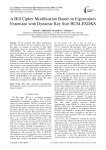
A Hill Cipher Modification Based on Eigenvalues Extension with Dynamic Key Size HCM-EXDKS
Статья научная
All the proposed Hill cipher modifications have been restricted to the use of dynamic keys only. In this paper, we propose an extension of Hill cipher modification based on eigenvalues HCM-EE, called HCM-EXDKS. The proposed extension generating dynamic encryption key matrix by exponentiation that is made efficiently with the help of eigenvalues, HCM-EXDKS introduces a new class of dynamic keys together with dynamically changing key size. Security of HCM-EXDKS is provided by the use of a large number of dynamic keys with variable size. The proposed extension is more effective in the encryption quality of RGB images than HCM-EE and Hill cipher-known modifications in the case of images with large single colour areas and slightly more effective otherwise. HCM-EXDKS almost has the same encryption time as HCM-EE, and HCM-HMAC. HCM-EXDKS is two times faster than HCM-H, having the best encryption quality among Hill cipher modifications compared versus HCM-EXDKS.
Бесплатно

A Hybrid Approach for the Multi-sensor Patrolling Problem in an Unknown Environment with Obstacles
Статья научная
This paper introduces PREFAP, an approach to solve the multi-sensor patrolling problem in unknown environment. The multi-sensor patrolling problem consists in moving a set of sensors on a pre-set territory such that each part of this territory is visited by the sensor agents as often as possible. Eachsensor has a communicational radius and a sensory radius. indeed, optimal patrol can only be achieved if the duration between two visits of the same area of the environment is as minimal as possible. This time between two visits is called idleness. Thus, an effective patrol technique must make it possible to minimize idleness in the environment.That is why after a deep analysis of the existing resolution’s approaches, we propose a hybrid approach of resolution with three components: perception-reaction, field of strength and learning. In absence of obstacles, the perception-reaction component gives to the sensors a purely reactive behavior, as a function of their local perceptions, which permit them to move easily in their environment. The strength module enables the sensors to avoid the obstacles in the environment. As regards to the learning module, it allows the sensors to get out of blocking situations encountered during obstacle avoidance. This approach, called PREFAP, must be able to minimize idleness in different areas of the environment. The simulation results obtained show that the approach developed effectively minimizes idleness in the environment. This allows on the one hand, to have a regular patrol in the environment; on the other hand, thanks to the minimization of idleness of the areas of the environment, PREFAP will allow the sensors to quickly detect the various possible events which can occur in different areas of the environment.
Бесплатно
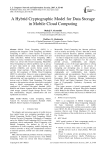
A Hybrid Cryptographic Model for Data Storage in Mobile Cloud Computing
Статья научная
Mobile Cloud Computing (MCC) is a paradigm that integrates Cloud Computing and Mobile Computing to deliver a better Quality of Experience (QoE) and Quality of Service (QoS) to mobile users and cloud subscribers. Mobile Cloud Computing (MCC) inherited resource limitation from Mobile Computing which was solved with Cloud Computing. Meanwhile, Cloud Computing has inherent problems such as privacy of user's data stored on cloud, intrusion detection, platform reliability, and security threats caused by multiple virtual machines. Thus, hindering the growth and the full acceptance of Mobile Cloud Computing (MCC) by subscribers. However, using a signature based hybrid cryptography ensures confidentiality, integrity, authentication and non-repudiation on resource-poverty devices used in Mobile Cloud Computing. This paper presents a data protection scheme where data is encrypted using a hybrid cryptographic algorithm which is composed of Advanced Encryption Standard (AES), Blake2b and Schnorr signature before being stored in the cloud storage (Amazon Simple Storage Server). Thus, data confidentiality, integrity, authentication and non-repudiation are ensured.
Бесплатно

